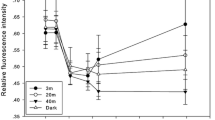Abstract
Porites coral in the nearshore waters off Hainan Island can give off yellowish-green fluorescence under UV laser induction. After fitting the data between rainfall and fluorescent intensity, it can be found that both appear in a simply linear equation with a correlation coefficient of 0.78. The model equation can be used to reconstruct the rainfall in the past time by means of the determined fluorescent intensity. The correlation diagram of the determined and calculated or hindcast rainfall shows a synchronous change from 1982 to 1997. The peak positions of the variant curve are usually related to the El’nino year. That means the drought and flood recycles are restrained to some extent by globally environmental changes. Therefore, the coral fluorescent intensity acts as a geochemical proxy for reconstructing the rainfall series in the past hundreds of years and predicting the drought-flood variant tendency in the future time.
Similar content being viewed by others
References
Boto, K. and P. Isdale, 1985, Fluorescent bands in massive corals result from terrestrial fulvic acid input to nearshore zone: Nature, v. 315, n. 30, p. 396.
Fang, L.S. and Y.C. Chou, 1992, Concentration of fulvic acid in the growth bands of hermatypic corals in relation to local precipitation: Coral Reefs, v. 11, p. 187.
Gong Daoyi and Wang Shaowu, 1999, ENSO influence on the precipitation of the land and China in last hundred years: Chinese Science Bulletion, v. 44, n. 3, p. 315.
He Xuexian, Peng Zicheng, Wang Zhaorong, and Nie Baofu, 1999, Advance in study on the coral paleo-environmental information: Advance in Earth Sciences, v. 14, n. 5, p. 505.
Isdale, P., 1984, Fluorescent bands in massive corals records centuries of coast rainfall: Nature, v. 310, n. 16, p. 578.
Klein, R., Y. Loya, and G. Gvirtzman, 1990, Seasonal rainfall in the Sinai desert during the Late Quaternary interred from fluorescent bands in fossil coral: Nature, v. 345, n. 10, p. 145.
Nie Baohu, Chen Tiegu, Liang Meitao, Zhong Jinliang, and Yu Kefu, 1997, The relationship between reef coral and environmental changes of Nansha Island and adjacent regions: Beijing, Science Press, p. 78.
Scoffin, T. P., A. W. Tudhope, and B. E. Brown, 1989, Fluorescent and skeletal density banding inPorites Lutea from Papua New Guinea and Indonesia: Coral Reefs, v. 7, p. 169.
Smith, T. J., J. H. Hudson, and M.B. Robblee, 1989, Freshwater flow from everglades to Florida bay: a historical reconstruction based on fluorescent banding in the coral solenaslrea bournoni: Bull, of Mar. Sci., v. 44, n. 1, p. 274.
Susie, M., K. Boto, and P. Isdale, 1991, Fluorescent humic bands in coral skeletons originate from terrestrial runoff: Mar. Chem., v. 33, p. 91.
Author information
Authors and Affiliations
Additional information
Jointly supported by NKBRSF Project Fund ( G1999043401 ), the National Natural Science Foundation of China (No. 49776307), the Innovation Project Fund of Chinese Academy of Sciences (KZCX1-Y-05) and the Resource and Environment Research Base fund.
Rights and permissions
About this article
Cite this article
Peng, Z., Xie, D., He, X. et al. The UV induced fluorescence inPorites coral from Hainan Island, China and its paleo-environmental implications. Chin. J. of Geochem. 20, 28–33 (2001). https://doi.org/10.1007/BF03166846
Issue Date:
DOI: https://doi.org/10.1007/BF03166846




